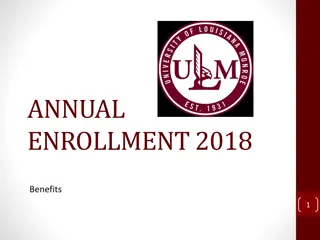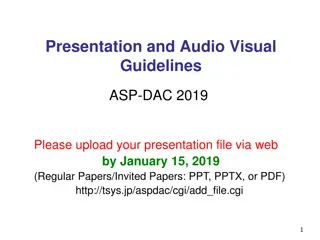Comprehensive Juvenile Sex Offender Treatment Services
Woodward Community Based Services offers a wide range of outpatient and residential programs for juvenile sex offenders, including mental health services, treatment programs, expressive therapies, and re-entry support. They utilize assessment tools and risk assessments to guide intervention planning and reduce reoffending rates. The background on adolescent sexual offending highlights the need for effective treatment methods.
Download Presentation

Please find below an Image/Link to download the presentation.
The content on the website is provided AS IS for your information and personal use only. It may not be sold, licensed, or shared on other websites without obtaining consent from the author.If you encounter any issues during the download, it is possible that the publisher has removed the file from their server.
You are allowed to download the files provided on this website for personal or commercial use, subject to the condition that they are used lawfully. All files are the property of their respective owners.
The content on the website is provided AS IS for your information and personal use only. It may not be sold, licensed, or shared on other websites without obtaining consent from the author.
E N D
Presentation Transcript
Woodward Community Based Services Juvenile Sex Offender Treatment ANDY-DIETZ SWENSON, t-LMHC PATRICK TURPIN, t-LMHC TESS HUGHES, LMHC, SOTP II JULIE SPONG
WCBS Services Outpatient Mental Health Services, including Telemental Health Services School Based Therapy Expressive Therapies- Art and Yoga Therapy Outpatient Sexual Offender Treatment Program BHIS Services Residential Foster Group Home Placement In-Home Adult Habilitation Services Outpatient Substance Abuse Services Re-entry Program Tracking and Monitoring Services
WCBS Juvenile S.O. Services Out-Patient Grant Individual & Group Treatment Aftercare Services S.O. Tracking Monitoring Psycho-Sexual Evaluations Polygraphs Sexual History Maintenance Risk Assessments JSSORAT and J-SOAP - II S.O. Informed Therapy Trauma Therapy Trauma Focused-CBT
Assessment Of Juvenile Sexual Offenders, Purpose Will estimate the likelihood that continued delinquent behaviors will occur for a youth Can guide intervention planning Provides standardized method of important data collection for an agency Provides common language It can reduce costs by identifying more intensive supervision and less over-use of expensive incarceration It can reduce reoffending rates Vincent et al (2012)
Risk Assessment Tools Juvenile Sexual Offender Assessment Protocol J-SOAP-II Estimate of Risk of Adolescent Sexual Offense Recidivism ERASOR Juvenile Sexual Offense Recidivism Risk Assessment J-SORRAT-II
SO Treatment, Background The Federal Bureau of Investigation s National Incident-based Reporting System shows that one-third of sexual assaults on children younger than 12 years of age involved an offender under 18 years of age (Rennison, 2001) At this time, there is no known reason that adolescents engage in inappropriate behaviors. There have been numerous theories proposed to explain the causes of sexually abusive behavior. Even so, there are no known empirically tested models involving the etiology of adolescent sexual offending.
Social Learning Theory & Integrative Theory Bandura s Social Learning Theory posits that people learn from one another. The Social Learning Theory maintains that sexually explicit materials serve as models for deviant sexual behaviors because they reinforce abnormal sexual impulses. It has been hypothesized that sexual arousal patterns are acquired and learned from observation and modeling (Kaplan, Krueger, & Vince, 2011). Integrative Theory, Ward and Beech (2005) attempted to integrate macro- level factors, such as evolutionary selection pressures and sociocultural factors, with individual factors such as genetic predispositions, early experiences of sexual or physical abuse, and individual differences in empathy, cognitive distortions, emotional problems, interpersonal competence, and sexual interests.
Risk-Need-Responsivity (RNR) Model The major approach to the treatment of sex offenders in North America, the United Kingdom, Australia, and New Zealand is the risk-need model Primary goal of treating offenders is to avoid harm to the community rather than to improve their quality of life Risk Factors it is a means to the end of reduced risk to the community Relapse Prevention Ward & Stewart, 2003 Traditionally, the Cognitive-Behavioral Treatment (CBT) approach has been the primary method to treat adolescents who engage in sexually abusive behaviors. CBT treatment encourages adolescents to identify treatment goals and thereby gain control of their deviant behaviors, correct distorted thinking, and develop relapse prevention strategies.
Alternative to RNR Model Second approach to treating offenders Attending to their human needs and levels of well-being Enhancement of offenders capabilities in order to improve the quality of their life, and by doing so, reduce their chances of committing further crimes against the community when they are done with treatment Skills, values, opportunities, social supports, etc. Roots in positive psychology and humanistic traditions (e.g., Diener & Myers, 1995) Developing research literature pointing to the crucial role of noncriminogenic needs in moderating treatment outcome Increasing sex offender self-esteem, working collaboratively in developing goals, and displaying empathy and warmth Ward & Stewart, 2003
Alternative to RNR Model Obvious that the model of choice should be the risk-need one? Simpler and it explicitly links the level of risk with the level of clinical problems and ultimately puts community safety above the interests of offender. However, does not pay sufficient attention to the issue of treatment responsivity and therefor should not be solely relied upon to treat sex offenders Ward & Stewart, 2003
The Good Lives Model (GLM) The Good Lives Model (GLM) developed by Ward and his colleagues (Ward & Brown, 2004) and has been systematically developed throughout this past decade. GLM is a strength-based holistic approach that analyzes the environment and the needs of an offender (Ward & Brown, 2004). Assumes that offenders typically share the human needs and aspirations of the rest of the community and that their offending occurs as a consequence of the way in which they seek the primary human goods emerging from these needs. The Good Lives Model helps the offender develop a good life by developing personal, interpersonal, and social goals (Willis & Ward, 2011; as cited in Smallbone, Rayment-Mchugh, & Smith 2013).
A Risk Management Approach Integrating GLM The GLM has been adopted as a grounding theoretical framework by several sex offender treatment programs internationally (McGrath, Cumming, Burchard, Zeoli & Ellerby, 2010) and is now being applied successfully in a case management setting for offenders. Andrews and Bonta (1998) posits the importance of noncriminogenic needs, but stated that a priority should be given to targeting criminogenic needs because of their positive impact on recidivism Anxiety, low self-esteem, and psychological distress may impede the establishment of a therapeutic alliance with offenders Before persons are capable of acquiring coping skills and prosocial attitudes, need to be motivated to participate in treatment Ward and Stewart, 2003
Woodward Community Based Services Outpatient Adolescent Sex Offender Rehabilitation Program Evaluation A Sex Offender Needs Assessment is completed upon intake J-SOAP-II and Phases Sexual Attitudes Questionnaire and the J-SOAP-II completed every six months Initial Treatment Plan Developed within 30 days of intake Components of the Treatment Planning include: The initial level and number of groups the youth will participate in The relevant Pathways and Good Lives Curriculum objectives for the youth Focusing on 5 overarching goal Connection Autonomy/Independence, Competence, Spirituality / Religion, Happiness/ Pleasure The number of individual sessions per week The youth s schedule that includes clear, collaborative expectations about supervision, skills-building, structured activities, curfew, and other parental expectations Level of supervision A plan for participation in all collateral services such as mental health, substance abuse, IHH, disability services deemed necessary A collaborative behavioral response plan A collaborative safety plan will be developed with representatives from all designated areas of the youth s life (school, home, community) so that all parties know their role in it
Woodward Community Based Services Outpatient Adolescent Sex Offender Rehabilitation Program Individual/Group Counseling Meets with an individual counselor weekly as well as weekly groups Three Phases Responsibility/Ownership Develop a safety plan Understands Situation and Behavior Before Offending Comprehends Thinking Errors and Emotions Recognizes Reactions to Life Events Polygraph Exam (as indicated) Motivation to Change Understands goals in offending Maintaining motivation Recognize and practice anticipating the problem Relapse Prevention Develop a relapse prevention plan How will others know that I am not meeting my goals Identifies a process for the gradual reduction of structure and supervision Establishes a process for continuation of the treatment interventions youth received in placement with the means to generalize what has been learned Establishes connections to the community resources the youth and family will receive upon return to the community;
Woodward Community Based Services Outpatient Adolescent Sex Offender Rehabilitation Program Discharge Summary Summary of progress towards goals in WCBS program. Address challenges of transition to adulthood including those specific to restrictions and requirements of the sex offender registry. Referrals for continued support in the community and at home. Individual/Family Therapy Offered to clients who are scored high or moderate risk on the Sex Offender Needs Assessment Referrals to Functional Family Therapy services (as indicated) SO Specific Tracking/Monitoring Offered to clients who have scored high risk on the Sex Offender Needs Assessment
Demographics WCBS Clients Male 85% Caucasian 15% mixed race, African American, & Hispanic 12-18 years old 14-16 years old, trending younger
Female Offenders Youthful offenders (6-12), and offenders with ID/DD is a growing subset of Juvenile SO population Roadmaps to Recovery has become primary modality for youthful (6-12) offenders and offenders with DD/ID Roadmaps is a trauma-sensitive intervention that supports development of resilience and provides strength-based modality for helping children change hurtful or problematic behavior patterns, while learning adaptive and healthy skills for productive and caring interpersonal skills Treatment topics include: -Distorted cognitive patterns and cognitive restructuring strategies -Managing sexual feelings -Self-care -Understanding Consequences of Problem Behavior -Pathways to problem sexual behavior -Healthy Boundaries -Clarification and Apologizing, Reunification -Victim Impact and Empathy -Safety Planning, Relapse Prevention Planning Special Populations Female Offenders Youthful Offenders Offenders With DD/ID
SO Tracking & Monitoring Checking for Safety Plan Violations Monitoring Electronics Nightly Call ins Random in person visits GPS monitoring Monitoring for red flags, early warning signs, concerning behavior
References Andrews, D.A., & Bonta, J. (1998). The psychology of criminal conduct (2nd ed.). Cincinnati, OH: Diener, E., & Myers, D.G. (1995). Who is happy? Psychological Science, 6, 10-19. Kaplan, M., Krueger, R., & Vince, M. (2011). A manual for understanding & treating adolescents who offenders. McGrath, R., Cumming, G., Burchard, B., Zeoli, S., & Ellerby, L. (2010). Current practices and emerging abuser management: The Safer Society 2009 North American survey. Brandon, Vermont: Safer Society Press. Rennison, C.M. (2001). Criminal victimization 2000 changes 1999-2000 with trends 1993-2000 (pp.1-16). 20531: U.S. Department of Justice. Bureau of Justice Statistics. National Crime Smallbone, S., Rayment-Mchugh, S., & Smith, D. (2013). Youth sexual offending: Context, good-enough lives, and engaging with a wider prevention agenda. International Journal of Behavioral Consultation and Therapy, 8, 3-4. Ward, T., & Beech, A. (2005). An integrated theory of sexual offending. Aggression and Violent Behavior, 11, 44 63. Ward, T., & Brown, M. (2004). The Good Lives Model and conceptual issues in offender Law, 10(3), 243-257. doi:10.1080/10683160410001662744 Ward, T. & Stewart, C.A. (2003). The treatment of sex offenders: Risk management and good lives. Professional Psychology: Research and Practice, 34(4) 353-360. Anderson. commit sexual trends in sexual Washington, DC Victimization Survey. rehabilitation. Psychology, Crime &
Assessment, Treatment Resources ERASOR www.erasor.org J-SOAP-II www.ncjrs.gov/html/ojjdp/202316/page4.html J-SORRAT-II www.cdcr.ca.gov/Parole/SARATSO_Committee/DOCS/California%20JSORRAT- II_ScoringSheet2_4-8-09.pdf JRAS www.nj.gov/oag/dcj/megan/jras-manual-scale-606.pdf DASH www.erasor.org JUVENILE SEX OFFENSE SPECIFIC TREATMENT NEEDS AND PROGRESS SCALE www.csom.org/pubs/JSOProgressScale.pdf TREATMENT MOTIVATION SCALE www.j- satresources.com/Toolkit/Juvenile/b8eda494-1417-4600-8a37-26e6b6bcde94























